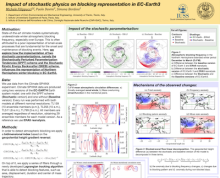Atmospheric Blocking Representation in EC-Earth Climate SPHINX Data with Stochastic Parameterization
Michele
Filippucci
University of Trento, IUSS Pavia
Poster
Atmospheric blocking is a mid-latitude weather pattern that strongly influences the climate of highly populated areas of the Northern Hemisphere. Blocking is a challenging phenomenon both for its complex and nonlinear dynamics and for its representation by numerical climate models. This research aims at investigating the impact of the implementation of stochastic parameterizations on atmospheric blocking representation by the EC-Earth Earth System Model.
More specifically, data from the Climate SPHINX project - which includes three different model resolutions with multiple ensemble members, with or without stochastic parameterizations - is analyzed. The analysis is carried out making use of an original Lagrangian tracking algorithm we developed, based on a geopotential height gradient reversal index.
Significant differences are found in blocking frequency over the Northern Hemisphere and, more specifically, in the North Atlantic. From the comparison between the model output and ERA5 reanalysis emerges how the stochastic parameterizations are deteriorating - rather than improving - the atmospheric blocking frequency representation. Therefore, we explore whether the systematic impact of the stochastic parameterization is caused by a different representation of the atmospheric blocking dynamics - assessed through the Lagrangian tracking algorithm - or by substantial differences in the mean climate. The analysis suggests that the mean state differences are at the basis of the different blocking representation.
Further inspection of mean fields and wave activity reveals that systematic Atlantic jet differences are caused by anomalous stationary waves in the tropical region. An increase of condensed water in the tropical clouds - due to an asymmetric contribution of stochastic perturbations to the condensation process - is forcing a Gill-Matsuno response that in turn alters the mid-latitude jet displacing the regions where atmospheric blocking preferentially occurs. Our results highlight the importance of taking into account mean circulation anomalies when the atmospheric blocking climatological frequency from different data sources - both models and reanalyses - are compared. Moreover, we find that the EC-Earth Earth System Model mid-latitude circulation is highly influenced by tropical wave activity.
More specifically, data from the Climate SPHINX project - which includes three different model resolutions with multiple ensemble members, with or without stochastic parameterizations - is analyzed. The analysis is carried out making use of an original Lagrangian tracking algorithm we developed, based on a geopotential height gradient reversal index.
Significant differences are found in blocking frequency over the Northern Hemisphere and, more specifically, in the North Atlantic. From the comparison between the model output and ERA5 reanalysis emerges how the stochastic parameterizations are deteriorating - rather than improving - the atmospheric blocking frequency representation. Therefore, we explore whether the systematic impact of the stochastic parameterization is caused by a different representation of the atmospheric blocking dynamics - assessed through the Lagrangian tracking algorithm - or by substantial differences in the mean climate. The analysis suggests that the mean state differences are at the basis of the different blocking representation.
Further inspection of mean fields and wave activity reveals that systematic Atlantic jet differences are caused by anomalous stationary waves in the tropical region. An increase of condensed water in the tropical clouds - due to an asymmetric contribution of stochastic perturbations to the condensation process - is forcing a Gill-Matsuno response that in turn alters the mid-latitude jet displacing the regions where atmospheric blocking preferentially occurs. Our results highlight the importance of taking into account mean circulation anomalies when the atmospheric blocking climatological frequency from different data sources - both models and reanalyses - are compared. Moreover, we find that the EC-Earth Earth System Model mid-latitude circulation is highly influenced by tropical wave activity.

Poster file
